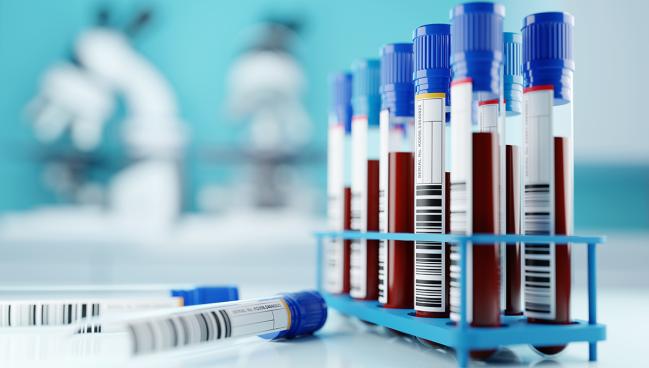Cardiac Biomarkers May Help Refine HF Risk Stratification, Progression
The findings from the ARIC cohort are suggestive of “a graded set of risks” within Stage B heart failure, says James L. Januzzi Jr.

Incorporating cardiac biomarkers into heart failure (HF) assessment may better pinpoint patients who otherwise would have been missed by older disease definitions, data from the ARIC study suggest. One in five asymptomatic elderly individuals in the study were reclassified from Stage A to Stage B through the inclusion of natriuretic peptide or cardiac troponin elevations.
“We found that the combination of biomarkers and echocardiographic abnormalities indicated patients with the highest risk overall,” said senior study author Vijay Nambi, MD, PhD (Baylor College of Medicine, Houston, TX). “But even individually, the biomarkers and/or echocardiogram identified individuals at high risk.”
The findings are in line with recommendations from the most recent HF guidelines from the American College of Cardiology (ACC), the American Heart Association (AHA), and the Heart Failure Society of America (HFSA). The guidelines revised the HF staging system, putting emphasis on early detection of stage A (at risk), and stage B or pre-HF (asymptomatic with structural evidence of heart dysfunction). In keeping with a proposed new universal definition of HF, the guidelines recommend blood tests for natriuretic peptides and cardiac troponin in Stage B assessment.
The study, led by Xiaoming Jia, MD (Baylor College of Medicine), showed that those with abnormal biomarkers alone had an increased risk for death, while those with abnormalities on echo alone had increased risk for HF hospitalization over a median follow-up period of 7.2 years.
“By incorporating biomarkers, what we're now able to do is take this group of folks who are at risk for heart failure and identify a graded set of risks even within the stage,” said James L. Januzzi Jr, MD (Massachusetts General Hospital, Boston), who commented on the findings for TCTMD.
“What these findings tell us is that people with abnormal biomarkers are at one level, people with abnormal echo are at another level, and when both are abnormal, the person is on the brink of developing symptomatic heart failure,” he added. “This is important because it not only affirms the universal definition of heart failure recommendations, but identifies opportunities for more widespread use of cardiac biomarker testing to identify a risk for heart failure at its earliest stages with the hope that we can intervene and reduce the risk.”
According to Nambi, there may eventually be a role for therapies such as sodium-glucose cotransporter 2 (SGLT2) inhibitors, which already have shown the ability to prevent death and worsening HF, to prevent HF in at-risk populations. Importantly, he hopes the data help to shift the paradigm of biomarker testing only in the acute phase, such as in patients with chest pain or shortness of breath, for example, to a broader patient population.
“Right now, HF detection is sort of reactionary, but the question is whether and how to get proactive [by] listening to these early signals that we are seeing,” Nambi said.
Insights into Individual Risk Type
For the study, published in JACC: Heart Failure, the investigators assessed 5,324 community-dwelling elderly individuals (mean age 75.8 years; 58.6% women; 24% Black) enrolled in ARIC who had no prevalent HF at index visit 5 (2011-2013). Overall, 51.6% had elevated N-terminal pro-B–type natriuretic peptide (NT-proBNP) levels and 33.3% had elevated high-sensitivity troponin T (hs-TnT). Under the new classification, approximately one in five individuals (21.1%) who had elevated cardiac biomarkers without echocardiographic abnormalities could be reclassified from Stage A to Stage B.
Compared with those with Stage A, those with Stage B had increased risk for incident HF (HR 3.89; 95% CI 2.71-5.58), HF with reduced ejection fraction (HFrEF; HR: 3.08; 95% CI 1.59-5.95), HF with preserved ejection fraction (HFpEF; HR 2.10; 95% CI 1.33-3.30), and all-cause death (HR 1.95; 95% CI 1.54-2.47) over the follow-up period.
Looking further at patients classified as Stage B by biomarker only (n = 1,123), echo findings only (n = 852), and biomarker plus echo findings (n = 2,351), the biomarker-only group had a higher risk of incident HF (HR 2.07; 95% CI 1.37-3.12), as did the echo-only group (HR 2.24; 95% CI 1.45-3.47), compared with those in Stage A. The biomarker-only group also had increased risk for all-cause death (HR 2.06; 95% CI 1.49-2.84), while the echo-only group did not. The biomarker-plus-echo-findings group had the highest risks of all groups for incident HF (HR 5.44; 95% CI 3.77-7.85), HFrEF (HR 5.20; 95% CI 2.64-10.26), HFpEF (HR 3.08; 95% CI 1.91-4.94), and all-cause death (HR 2.76; 95% CI 2.06-3.69).
Secondary analyses showed that NT-proBNP and hs-TnT were associated with similar patterns of increased risk. They further indicated that individuals with biomarker elevations and echo abnormalities were more likely to have chamber enlargement, decreased LVEF, regional wall motion abnormality, diastolic dysfunction, and valvular abnormalities than Stage B individuals with echo abnormalities alone.
Right now, HF detection is sort of reactionary, but the question is whether and how to get proactive [by] listening to these early signals that we are seeing. Vijay Nambi
The investigators also looked at an earlier time points in the ARIC cohort, when individuals were a mean age of 57 years and again at a mean age of 63. Of those with elevated NT-proBNP at age 57, 28.5% had further increases by age 63, and of those with elevated hs-TnT at age 57, 8.5% had further increases by age 63.
Although the guidelines remind clinicians that there can be potential noncardiac causes of elevated natriuretic peptides, including advanced age, Januzzi said biomarkers tell a story regardless of how old a patient may be.
“In other words, it's not a false-positive to see an abnormal biomarker in an older patient. What the test is detecting is the age-related changes of the heart that may be occurring, which may include cardiac dysfunction,” he said. “In an 80-year-old, it may be related to age-related development of heart muscle stiffening, the presence of atrial fibrillation, or other age related comorbidities. But, it shouldn't be ignored just purely on the basis of age alone. One needs to look at the patient and put the biomarker result in context.”
Younger Patients and Personalized Medicine
Nambi said the findings of elevated biomarkers even at the earlier time point argues for broader testing in younger populations, too, with an eye toward making them part of routine workups in middle age in order to intensively treat as early as possible.
“The other part of this research that is exciting is being able to identify the lowest-risk individuals and seeing what happens as they age,” Nambi told TCTMD. “When we talk about personalized medicine, [biomarkers] are the kind of tools that can be used to help us achieve that.”
A biomarker-inclusive approach also has the potential for cost-saving, he added, by allowing for earlier treatment that may prevent HF events and hospitalizations.
The clinical implications may encompass a wide swath of diseases that intersect with HF. Januzzi recently co-authored a consensus document advocating for natriuretic peptide or troponin measurement at least yearly in people with diabetes to identify the presence of Stage B HF.
“Ultimately, we're going to need better tools than just these simple tests that we now have in order to refine the risk stratification approach to all individuals, I would argue. But presently, we're still trying to focus this approach, which I don't like calling ‘screening,’ because screening implies a more random evaluation. Really what we're trying to do is diagnose heart failure at an earlier stage in those individuals at highest risk,” he noted. “With rapid development of newer biomarker strategies leveraged by artificial intelligence and other technologies, clinicians can expect that this is going to not only be more and more common, but the accuracy of the diagnostic approach will continue to improve.”
L.A. McKeown is a Senior Medical Journalist for TCTMD, the Section Editor of CV Team Forum, and Senior Medical…
Read Full BioSources
Jia X, Al Rifai M, Ndumele CE, et al. Reclassification of pre-heart failure stages using cardiac biomarkers: Atherosclerosis Risk in Communities (ARIC) study. J Am Coll Cardiol HF. 2023;Epub ahead of print.
Disclosures
- Nambi reports stock ownership in Abbott Labs.
- Januzzi reports serving as a board member of Imbria Pharmaceuticals and receiving research support from Abbott, Applied Therapeutics, Innolife, Novartis Pharmaceuticals, and Roche Diagnostics. He reports receiving consulting income from Abbott, Beckman, Bristol Myers Squibb, Boehringer Ingelheim, Janssen, Novartis, Pfizer, Merck, Roche Diagnostics, and Siemens and participating in clinical endpoint committees/data safety monitoring boards for Abbott, AbbVie, Bayer, CVRx, Intercept, Janssen, and Takeda.





Comments